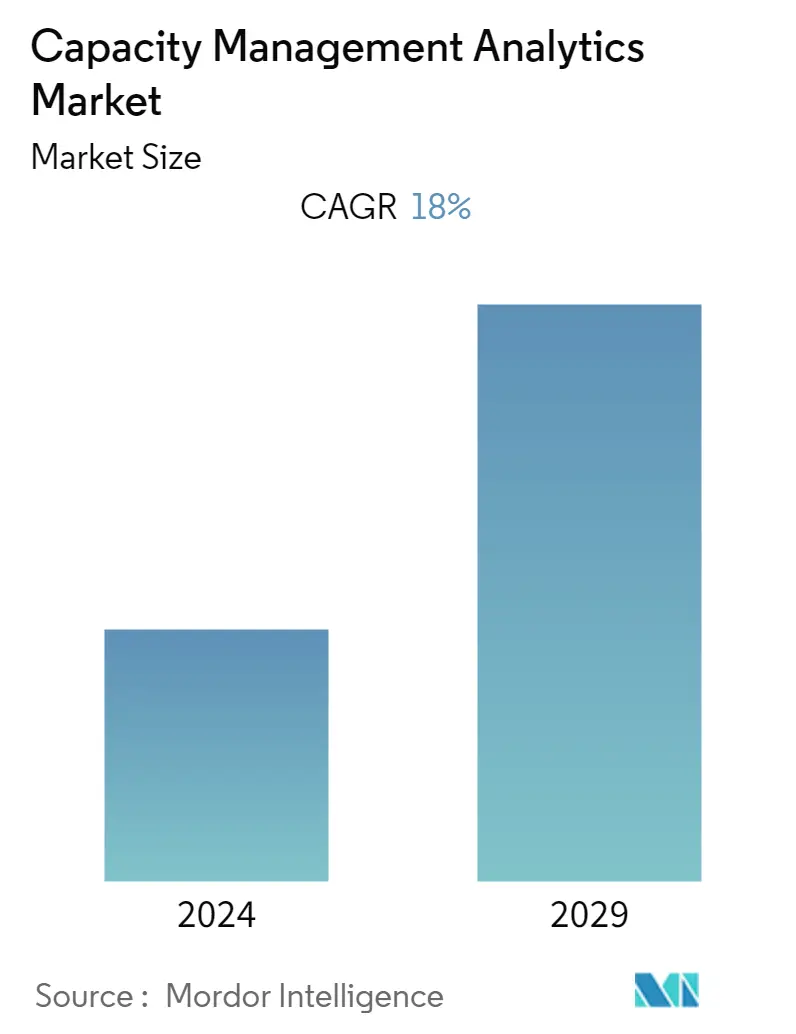Market Size of Capacity Management Analytics Industry

| Study Period | 2019 - 2029 |
| Base Year For Estimation | 2023 |
| CAGR | 18.00 % |
| Fastest Growing Market | Asia Pacific |
| Largest Market | North America |
| Market Concentration | Medium |
Major Players
*Disclaimer: Major Players sorted in no particular order |
Capacity Management Analytics Market Analysis
The Capacity Management Analytics Market is expected to register a CAGR of 18% during the forecast period (2020 - 2025). As the business environment is growing and the workloads are changing, the techniques that were once optimal are no longer feasible. Capacity management analytics primarily predicts the changes in the operations and autonomously rebalances the workloads in real-time as the condition changes, thereby avoiding the performance issues while significantly reducing virtual machine motioning and volatility.
- Multiple organizations today are combatting the risks that are related to the virtualized infrastructure by significantly over-provisioning their hardware. The excess capacity is basically a cost that is currently viewed as a necessary solution owing to the rising complexity of new business environments. This inefficiency can however be avoided with the optimization of workload placements and right-sizing the virtual machine (VM) allocations in order to simultaneously combat both risk and capacity waste.
- The management of the IT infrastructure has become much more complex in the past few years and organizations are increasingly augmenting or replacing their in-house systems with scalable resources that are being provided by cloud services. The cloud services primarily require the same level of capacity and performance management as an on-premises system, which has led to the creation of holistic capacity management and planning tools in order to adequately address these hybrid environments in the management process.
- Capacity management solutions provides multiple benefits to an organization and is a factor in overall management of a computing infrastructure. In addition to ensure that all the systems are performing at an adequate levels, these analytics solution also helps in realizing cost savings by avoiding the over-provisioning of hardware and software resources. It also helps saving time by identifying extraneous activities such as backing up unused data or maintaining idle servers.
- Owing to the recent outbreak of coronavirus, there is shift in usage from mobile internet to fixed-line broadband, adding significant revenue strain for the mobile-only CSPs in some regions. The CSPs, are currently in a crucial need to optimize their capacity in order to provide seamless service to their users.
Capacity Management Analytics Industry Segmentation
The capacity management analytics solution primarily provides the IT infrastructure system managers, administrators, and the data center executives with access to all the information they majorly need to optimize their IT infrastructure availability, performance, and scalability. With the usage of the measurement and management of the available and planned capacity, IT teams can rapidly move from insight to action stage in order to improve services for their businesses.
| By Deployment | |
| On-premise | |
| Cloud |
| By End-user Industry | |
| IT & Telecom | |
| Healthcare | |
| Manufacturing | |
| BFSI | |
| Government | |
| Other End-user Industries |
| Geography | |
| North America | |
| Europe | |
| Asia Pacific | |
| Latin America | |
| Middle East and Africa |
Capacity Management Analytics Market Size Summary
The Capacity Management Analytics Market is experiencing significant growth, driven by the need for organizations to adapt to evolving business environments and the complexities of IT infrastructure management. As traditional techniques become less effective, capacity management analytics offers solutions that predict operational changes and autonomously rebalance workloads in real-time, thereby enhancing performance and reducing inefficiencies. This is particularly crucial as organizations increasingly shift towards cloud services, which require robust capacity and performance management akin to on-premises systems. The integration of digital transformation technologies, such as IoT and big data, in manufacturing and other sectors is further propelling the demand for these analytics solutions, enabling better resource utilization and cost savings.
The market is characterized by a competitive landscape with numerous players offering capacity management analytics solutions globally. North America is poised for significant growth due to the presence of major solution providers and the region's focus on innovation and technological advancements. Companies in this region are early adopters of advanced technologies, driving demand for analytics solutions to streamline processes and gain deeper insights. The market's competitive nature is underscored by strategies such as mergers, acquisitions, and product innovation, with key players like IBM, Broadcom, and VMware leading the charge. Recent developments, such as Syncsort's acquisition of Pitney Bowes' software and data business, highlight the ongoing consolidation and expansion efforts within the market.
Capacity Management Analytics Market Size - Table of Contents
-
1. MARKET DYNAMICS
-
1.1 Market Overview
-
1.2 Market Drivers
-
1.2.1 Increasing Need for Optimization and Effective Utilization of IT Infrastructures
-
1.2.2 Increasing Complexities in IT Infrastructures
-
-
1.3 Market Restraints
-
1.3.1 Lower Adoption Among the SMEs
-
-
1.4 Porters Five Force Analysis
-
1.4.1 Threat of New Entrants
-
1.4.2 Bargaining Power of Buyers/Consumers
-
1.4.3 Bargaining Power of Suppliers
-
1.4.4 Threat of Substitute Products
-
1.4.5 Intensity of Competitive Rivalry
-
-
-
2. MARKET SEGMENTATION
-
2.1 By Deployment
-
2.1.1 On-premise
-
2.1.2 Cloud
-
-
2.2 By End-user Industry
-
2.2.1 IT & Telecom
-
2.2.2 Healthcare
-
2.2.3 Manufacturing
-
2.2.4 BFSI
-
2.2.5 Government
-
2.2.6 Other End-user Industries
-
-
2.3 Geography
-
2.3.1 North America
-
2.3.2 Europe
-
2.3.3 Asia Pacific
-
2.3.4 Latin America
-
2.3.5 Middle East and Africa
-
-
Capacity Management Analytics Market Size FAQs
What is the current Capacity Management Analytics Market size?
The Capacity Management Analytics Market is projected to register a CAGR of 18% during the forecast period (2024-2029)
Who are the key players in Capacity Management Analytics Market?
IBM Corporation, Broadcom Inc., NetApp, Inc., Hewlett Packard Enterprise Company and VMware, Inc. are the major companies operating in the Capacity Management Analytics Market.

